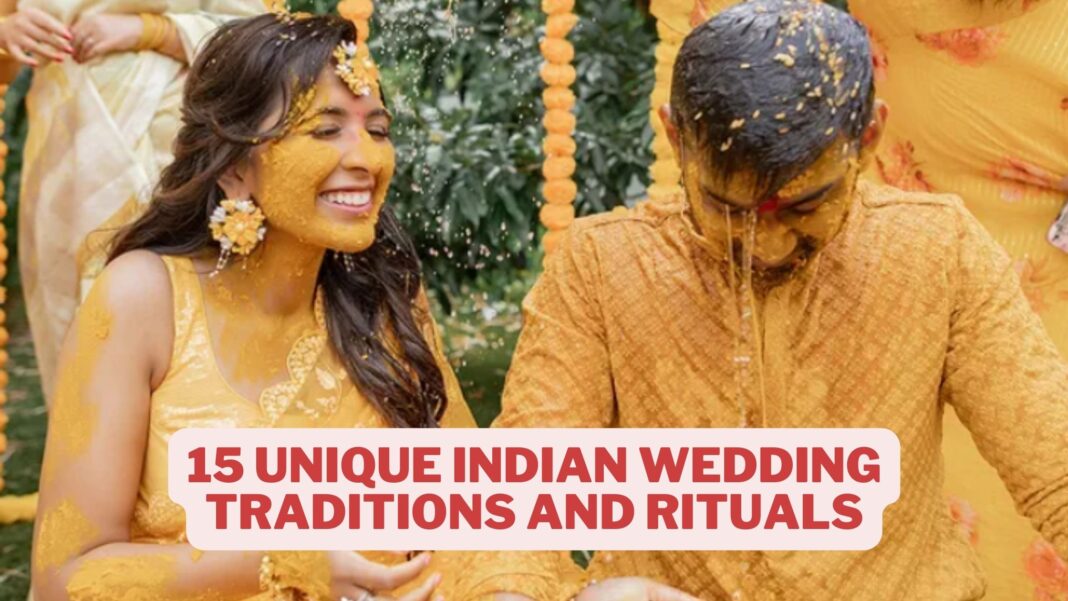Indian weddings, a vibrant tapestry of customs, celebrate family, love, and heritage. Mehndi, Sangeet, saat phere, and joota chupai are a few of the 15 unique Indian wedding traditions steeped in profound symbolism. From the sacred fire’s rounds to playful shoe-stealing antics, each ritual paints love, joy, and unity. These weddings blend tradition with modernity, honoring a rich cultural past. They’re more than celebrations; they’re odes to love, family, and heritage, weaving unforgettable memories in hearts.
List of Most Common Indian Wedding Traditions
1. Misri Tradition in Indian wedding traditions:
The Misri ceremony, preceding the wedding, witnesses the exchange of prayers, flower garlands, and gold rings between the soon-to-be newlyweds. Symbolizing sweetness in marriage, Misri, rock sugar, is exchanged alongside a basket of gifts from the groom’s parents, encapsulating wishes for a joyous and prosperous union. This cherished pre-wedding ritual embraces the essence of blessings, prayers, and the heartfelt exchange of symbolic tokens, signifying the beginning of a life imbued with sweetness and happiness for the couple.

2. Haldi Tradition in unique way
The Haldi tradition, a cherished pre-wedding ritual in Indian weddings, is a beautiful celebration steeped in tradition and symbolism. This vibrant ritual involves the application of turmeric paste, known for its auspicious and purifying properties, on the bride and groom. Beyond its cosmetic significance, the tradition holds deep cultural and spiritual importance.
Families and loved ones come together, adorning the soon-to-be-wed couple with the bright yellow paste. It symbolizes not just the auspiciousness of the occasion but also purity and blessings for a radiant future together. The application of Haldi is believed to bring a natural glow to the bride and groom, enhancing their beauty as they embark on this new chapter of their lives.
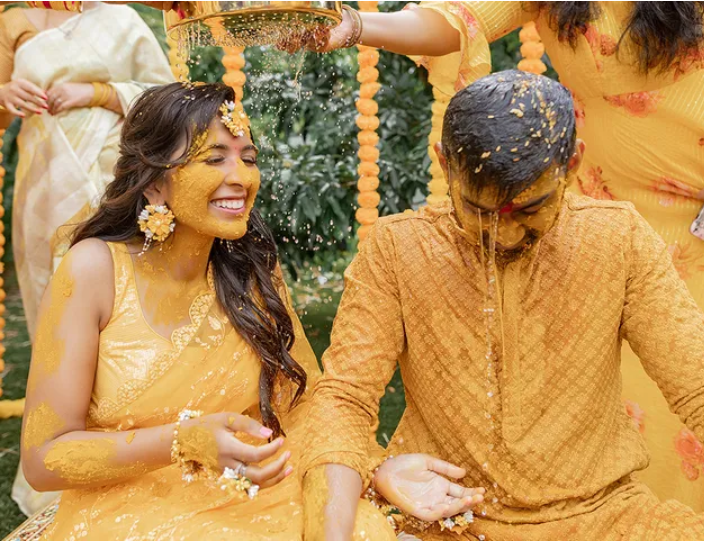
3. Mehendi Tradition
The artful application of henna, known as Mehendi, is a cherished pre-wedding tradition that holds profound significance in Indian culture. The intricate patterns adorning the bride’s hands and feet during the Mehendi tradition signify more than just decorative designs; they embody a tapestry of love, joy, and spiritual awakening.
Each delicate swirl and motif woven into the Mehendi carries a symbolism deeply rooted in tradition. The elaborate patterns symbolize prosperity, love, and blessings, invoking an aura of celebration and festivity around the bride. Additionally, it’s believed that the deeper the color of the Mehendi stain, the stronger the bond of love between the couple, signifying the intensity and depth of their relationship.
This ritual also carries a delightful superstition – until the Mehendi fades, the bride is traditionally exempt from household chores. This period becomes a time of celebration and pampering for the bride as she eagerly awaits the richness of the Mehendi’s hue to deepen, signifying the strength and depth of her marital bond.
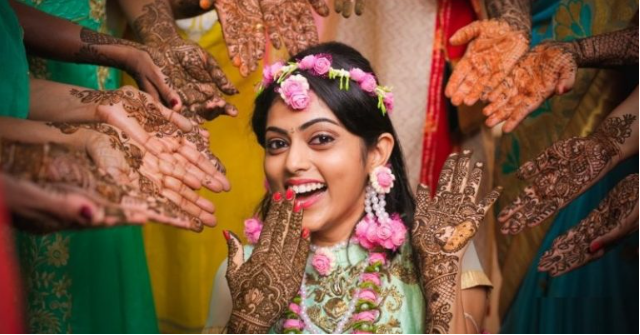
4. Sangeet Tradition
The Sangeet, a vibrant and jubilant pre-wedding tradition in Indian weddings, radiates with music, dance, and exuberant celebrations. This festive night serves as a joyous amalgamation where the families of the bride and groom converge to revel in an evening of performances, creating unforgettable memories.
Amidst an ambiance filled with laughter and melodies, the Sangeet marks a significant moment where both families join in celebration, strengthening bonds and forging new connections. It’s a platform for showcasing cultural richness through lively dance performances, soulful music, and engaging skits that narrate tales of love and unity.
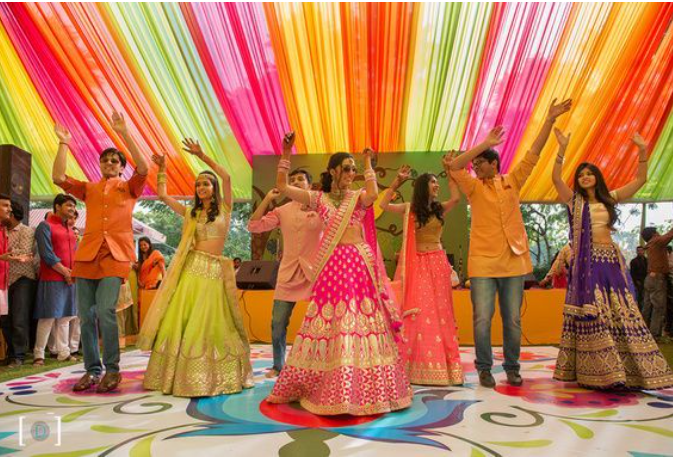
5. Baraat
The grand entry of the groom, heralded by the Baraat procession, marks a momentous tradition in Indian weddings, steeped in symbolism and jubilation. This vibrant procession signifies the groom’s arrival to claim his bride and commence the wedding festivities.
Accompanied by exuberant music, dancing, and jubilant celebrations, the Baraat is a magnificent spectacle. Traditionally, the groom embarks on this procession riding a decorated horse or elephant, adorned regally as he leads a joyous entourage of family and friends towards the wedding venue. This jubilant journey is not merely a passage to the tradition; it’s a celebration in its own right, resonating with the spirit of festivity and anticipation.
This tradition transcends the mere act of arrival; it’s a celebration of love, unity, and the joyous union of two families. The Baraat procession captures the essence of Indian weddings, igniting the fervor of festivity and marking the commencement of a joyous union between two souls.

6. The Wedding Mandap
The Mandap, adorned with a sacred canopy, stands as a sanctified space representing the universe in Indian weddings. Under its divine shelter, a tapestry of rituals unfolds, each imbued with profound symbolism signifying the union of the couple and their commitment to a lifelong journey together.
The sacred canopy itself symbolizes the cosmos, encompassing the universe’s boundless expanse. Beneath this celestial representation, pivotal rituals transpire, resonating with spiritual significance and cultural heritage. The exchange of floral garlands, known as Jaimala, signifies the mutual acceptance and respect between the bride and groom, marking the beginning of their journey as partners in life.
Further enhancing the sanctity of the Mandap are fire ceremonies like the sacred Agni Pooja, where the couple makes solemn promises and offerings to the divine fire. This ritual represents purity, vitality, and the eternal flame of love that will illuminate their path together.
The Mandap becomes a sacred altar, witnessing the union of hearts and souls as the couple embarks on this sacred union. Each ritual conducted under its shelter represents the weaving together of two lives, their families, and their destinies, uniting in a bond that transcends time and space.
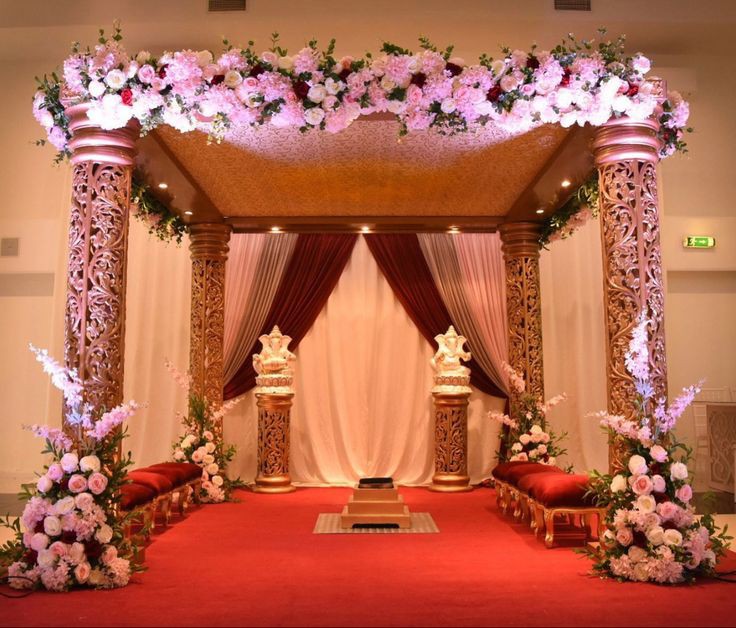
7. Jutta Chupai
On the wedding morning, the groom visits his future in-laws’ home. There, the mother-in-law washes his feet, offering milk and honey symbolizing blessings and sweetness. Concurrently, the sister-in-law mischievously attempts to “steal” his shoes in the playful Jutta Chupai. If successful, she claims a token payment from the groom to return the shoes before the ceremony begins. This endearing tradition blends joviality with customs, fostering camaraderie and adding a touch of playful joy to the auspicious wedding day.
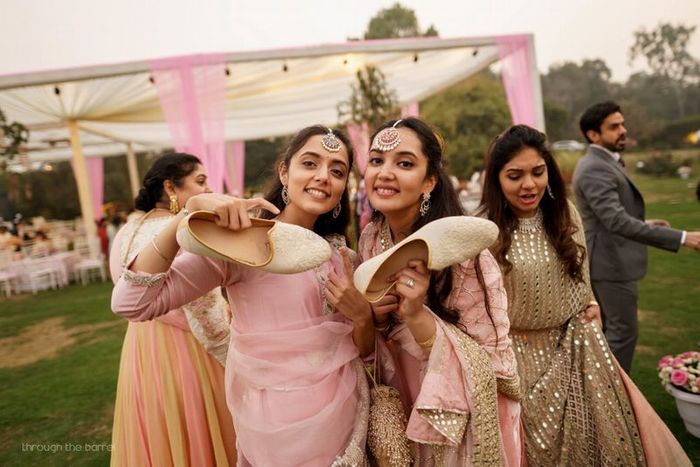
8. Vidaai tradition
The Vidaai, a deeply emotional and poignant moment in Indian weddings, marks the bride’s departure from her parental home to embark on a new chapter of her life with her husband. This bittersweet ritual carries immense emotional significance, encapsulating a blend of tears, joy, and heartfelt blessings.
Amidst an atmosphere tinged with both sadness and celebration, the Vidaai symbolizes a moment of transition and transformation for the bride and her family. It’s a farewell filled with tears of affection and nostalgia as the bride bids adieu to her childhood abode, leaving behind cherished memories to embrace the promise of a new life.
The Vidaai ritual is a poignant reminder of the love and support the bride receives from her family, who shower her with heartfelt blessings for a prosperous and blissful married life. This emotional farewell represents a profound shift as the bride steps into the unknown, yet with the reassurance of her family’s love guiding her forward.

9. The Seven Steps
In Hindu weddings, the Saptapadi, or the ritual of the seven vows, holds immense significance as the couple embarks on a sacred journey together. Encircling the holy fire, the bride and groom take seven steps, each step symbolizing a profound vow and commitment they make to each other.
The seven vows taken during the Saptapadi encompass a range of promises that form the foundation of a harmonious and enduring marital bond. Each step signifies a pledge, including promises to cherish and respect each other, to uphold mutual trust and understanding, and to support each other in times of joy and sorrow.
These sacred vows also involve commitments to shared responsibilities, including the welfare of their families, the nurturing of their future generations, and the pursuit of a harmonious life together. The couple promises to walk hand in hand, overcoming obstacles, and rejoicing in their successes as equal partners in life’s journey.
The significance of the Saptapadi extends beyond mere words; it symbolizes the couple’s willingness to embark on a shared path, promising to stand by each other through life’s trials and triumphs. The sacredness of the vows taken around the fire signifies the eternal flame of love and commitment that will guide and illuminate their married life.
The Saptapadi stands as a sacred testament to the essence of Hindu weddings, embodying the core values of love, trust, mutual respect, and the promises that bind two souls together in a lifelong union.
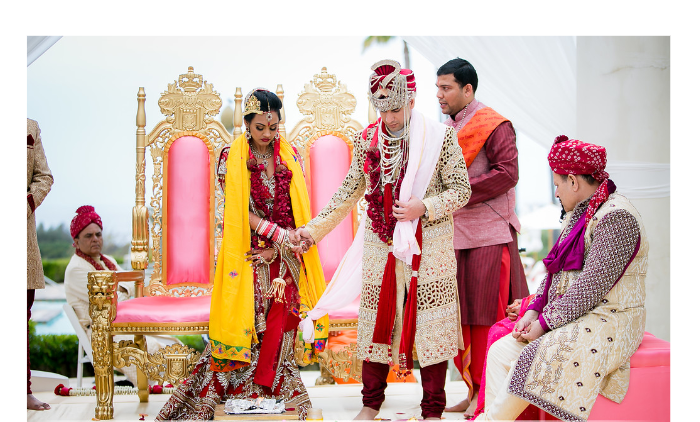
10. Lighting The Fire
The Agni, symbolizing purity and transformation, takes center stage in Indian weddings. Serving as a sacred witness, it holds profound significance. Encircling the holy fire, the couple takes seven solemn steps, reciting sacred vows, and pledging their commitment to each other. This ritual, known as the Saptapadi, signifies their journey together, promising mutual love, respect, and shared responsibilities. The holy fire becomes the sanctified witness to their union, infusing the ceremony with spirituality, symbolizing the eternal flame of love, and marking the inception of a lifelong bond sealed by sacred promises.
11. Laja Homa
During the ceremony, the Laja homa ritual unfolds, involving the bride’s brother pouring rice into her cupped hands. The groom, positioned below, extends his cupped hands, allowing some rice to spill into his palms before slipping into the sacred fire. This symbolic act signifies the bride’s brother entrusting her care to the groom, symbolizing unity, and fostering a harmonious union between the families.

12. Mangalsultra
In Hindu weddings, rather than exchanging rings, the groom ceremoniously ties a mangalsutra, a necklace with two gold pendants, around his bride’s neck, securing it with three knots. This symbolic act signifies a resilient, enduring union, akin to the significance of rings in Western culture. The mangalsutra holds deep cultural and social importance, symbolizing a woman’s marital status and her commitment to the sacred bond of marriage. Each knot represents virtues like duty, love, and commitment, encapsulating the essence of a strong, time-honored union in Indian tradition.
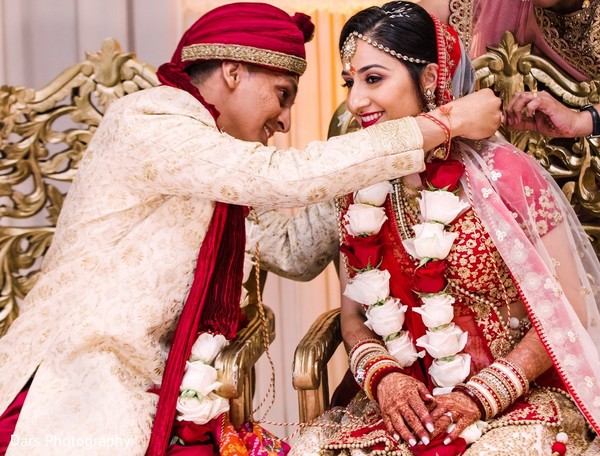
13. Bridal Lehanga
The bride’s attire in Indian weddings is an embodiment of cultural richness and heritage, showcasing a mesmerizing diversity that varies across regions and communities. Each piece of traditional clothing, whether it’s the resplendent saree or the ornate lehenga, holds profound cultural significance, transcending fashion to become a symbol of tradition and identity.
The saree, draped in various styles across India, holds an iconic place in bridal wear. Its elegant drape signifies grace, femininity, and timeless beauty. The richness of its fabric, intricate embroidery, and embellishments reflect the bride’s cultural heritage and family traditions, often passed down through generations.
On the other hand, the lehenga, with its voluminous skirt and intricately embroidered blouse, exudes opulence and grandeur. Each motif and pattern woven into its fabric holds a story, often representing auspicious symbols or regional motifs that celebrate the bride’s cultural roots.
Every element of the bride’s attire, from the sparkling jewelry to the intricate henna designs, weaves together a tale of tradition and artistry. These garments are not just fabrics; they are repositories of cultural values, showcasing a bride’s reverence for her heritage and the customs of her community.
Moreover, the choice of attire often reflects the regional customs and practices, with variations in colors, fabrics, and styles reflecting the distinctiveness of each culture. Despite the diversity, the common thread among these attires is their ability to evoke a sense of pride, identity, and connection to tradition, creating a visual tapestry that celebrates the bride’s cultural heritage on her special day.

14. Food and Feasts
Weddings in India are a feast for the senses, with a tantalizing array of traditional delicacies that delight the palate. Culinary customs during these celebrations are a testament to the country’s rich cultural diversity, where each region boasts its own unique and flavorful cuisine. However, the underlying theme of generosity and abundance in hospitality remains a consistent hallmark across all weddings.
From aromatic biryanis and rich curries in the north to the tangy spices and savory dosas of the south, every region’s cuisine offers a diverse and exquisite gastronomic experience. These traditional dishes aren’t just meals; they’re a reflection of centuries-old culinary traditions passed down through generations, infused with local flavors and indigenous ingredients.
The wedding feast, known as the ‘shaadi ka khaana,’ is an extravagant affair where an assortment of delectable dishes graces the tables. It’s a culinary symphony that brings families and communities together, epitomizing the spirit of celebration and togetherness.
Despite the regional variations, the emphasis on hospitality, generosity, and abundance remains a constant. Guests are welcomed with open arms and treated to an array of mouthwatering dishes, ensuring that no one leaves the celebration on an empty stomach.
The culinary customs at Indian weddings not only satiate appetites but also symbolize warmth, camaraderie, and the joy of sharing a meal with loved ones. It’s this spirit of culinary diversity and communal feasting that adds an unforgettable flavor to the celebrations, leaving guests with lasting memories of a sumptuous and culturally rich experience.
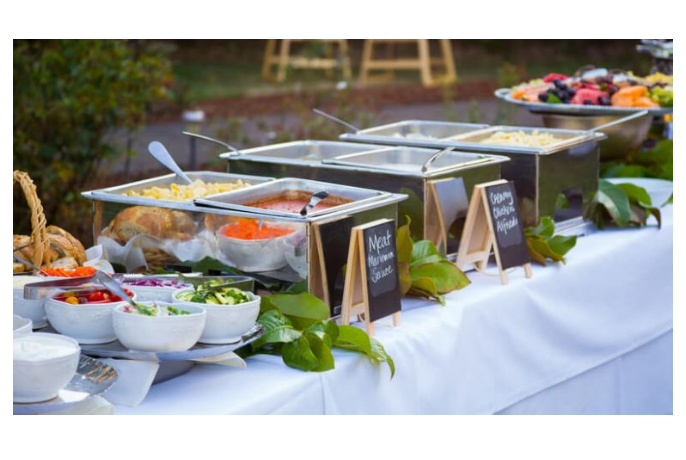
15. Music and Dance
Music and dance form the beating heart of Indian weddings, infusing these celebrations with an unparalleled spirit of jubilation and joy. They serve as integral elements that set the tone for the festivity, transforming the entire event into a lively and vibrant affair.
The diverse music genres showcased during Indian weddings encapsulate a rich tapestry of sounds. From the soulful strains of classical melodies to the energetic beats of Bollywood tunes, each musical note carries the essence of celebration. Traditional instruments like the tabla, dhol, and shehnai, alongside modern elements, blend harmoniously, creating a symphony that resonates with the spirit of the occasion.
Dance performances are another hallmark of these celebrations. From graceful classical performances to energetic and synchronized choreography, the dance floor becomes a stage for revelry and expression. Family and friends come together to showcase their talents, adding to the vivacity of the event.
The music and dance during Indian weddings transcend mere entertainment; they foster an atmosphere of exuberance, encouraging guests to participate and immerse themselves in the joyous celebrations. They unite people across generations and cultures, igniting a sense of camaraderie and fostering a shared experience of happiness and celebration.
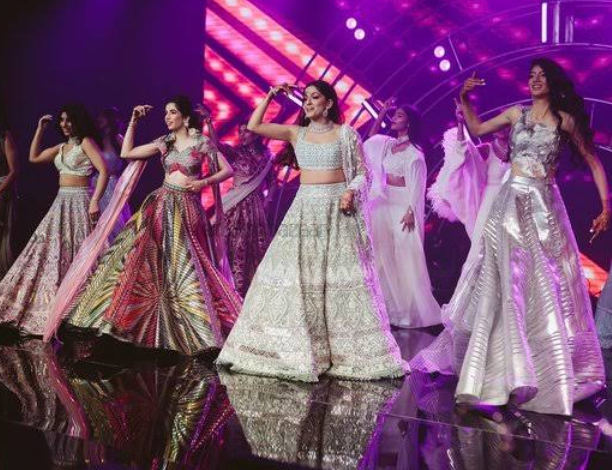
Conclusion:
In the tapestry of life, Indian wedding traditions stand as vibrant threads intricately woven together, showcasing a kaleidoscope of customs that resonate with the richness of culture, love, and togetherness. These timeless rituals serve as pillars that uphold the sanctity of family bonds and community ties, continuing to thrive through generations.
As each tradition unfolds, from the haldi-adorned hands to the Saptapadi’s solemn vows, these rituals become living legacies, uniting families and communities in joyous celebration. They encapsulate the essence of tradition, embodying the values of respect, unity, and reverence for cultural heritage.
Through the passage of time, these customs persist, carrying forward the tales of love and the enduring spirit of togetherness. They serve as reminders that amidst the evolving landscapes of modernity, the roots of tradition remain deeply embedded, binding hearts and souls in a tapestry of shared experiences and cherished moments.
Indian wedding traditions are not merely ceremonies; they are a beautiful symphony of customs, melodies, colors, and emotions that paint an indelible picture of love and familial bonds. They stand as a testament to the resilience of traditions, weaving together the past, present, and future in a celebration of culture, unity, and the everlasting beauty of shared moments.
FAQ:
1. What rituals to follow during a wedding?
Various rituals like vows, exchanging rings, sacred fire ceremonies, applying sindoor, tying mangalsutra, and seeking elders’ blessings are common.
2. Which is the most important wedding tradition?
Exchanging vows, rings, and seeking blessings from elders are often considered significant in many cultures.
3. What are the most unique wedding traditions?
Unique traditions include breaking a glass in Jewish ceremonies, gatecrashing games in Chinese weddings, Haldi ceremonies in Indian weddings, and jumping the broom in African American weddings.
4. How can I make my wedding unique in India?
Incorporate personal touches, cultural elements, unique entertainment, custom decor, personalized vows, or non-traditional rituals to reflect your personalities and create an unforgettable celebration.


